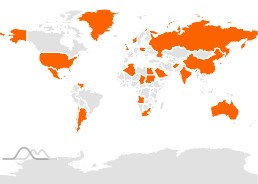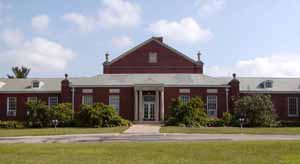Since at least 1947, Nicaraguan students have been attending the University of Illinois. Early Nicaraguan Illini have included architects, soccer players, and student leaders too.
Read on to learn more about early Nicaraguan Illini!
Illinois – Nicaragua Connections
Before coming to Illinois, it was for academic year 1879-1880, when future Pedagogy Professor William Julius Eckoff was president of the Collegio Nacional de Granada in Nicaragua. [1]
Later, during the late 1890s, talk about a shipping canal constructed across Nicaragua was popular on campus. In 1894, the Civil Engineer’s Club discussed discussed the history of Nicaraguan canal thus far. In 1895, Adelphic Society members debated if the United States should issue bonds to build a canal in Nicaragua, and other college debate societies across the country debated U.S. involvement. By 1900, Adelphic Society had hosted another talk about the canal. During the 1930s, canal construction debate resumed. In 1932, Lt. Col. Dan I. Suton, head of the Chicago district of United States Engineers, came to campus to discuss the difficulties identified by a recent survey.
During the 1910s and 1920s, at least one Nicaraguan musician came to town on at least two occasions. In 1915, son of former Nicaraguan president José Santos Zelaya, Don Alfonso Zelaya was a pianist and his tour brought him to the Orpheum Theater for three nights. Newspaper advertisements billed Mr. Zelaya as both “The Eminent Pianist” and “Son of the ex-president of Nicaragua”. In 1921, just seven years later, he returned to town for another performance.
In 1924, historian (and future archivist) Dr. Roscoe R. Hill visited campus and gave a lecture titled “The Problems of Central America”. From 1920 through 1928, Dr. Hill had served in the U.S. State Department, where he was part of the Nicaraguan High Commission and later the Nicaraguan War Claims Commission.
At least as early as the 1960s, direct campus connections with Nicaragua are identifiable. For example, during the late 1960s, Geology Professor Ralph E. Grim (Record Series 15/11/27) as a consultant for the Development and Resources Corporation, including work Nicaragua. Not long later, from 1984 through 1991, the student group People’s Alliance on Central American (Record Series 41/66/108) organized to discuss the U.S. military and political involvement in Central America. They produced publications too (Record Series 41/66/808).
Alumni
But prior to those connections, Illini were already following international careers including work in Nicaragua.
Perhaps one of the earliest Illini to do so and although already an experienced traveler of the Klondyke and Mexico, Mr. Elmer Church “Calamity” Smith (B.S. Civil Engineering, 1899), of Columbus, Nebraska, took a position with the Isthmian Canal Commission which brought him to working on railroad lines in Nicaragua in 1899. From Nicaragua, Mr. Smith would later relocate to Panama where he would remain until his passing in 1906. [2]
The second Illini to follow a career in Nicaragua was also quite likely the first Illini to spend over forty years in the Nicaragua too. Former Varsity track manager and Daily Illini athletics editor, Mr. Irving A. I. Lindberg, (A.B. 1910) took a position as an accountant in Nicaragua and he would remain there until retirement. [3] During his forty years in Nicaragua, Mr. Lindberg would become High Commissioner and Collector of Customs, and he would be credited with reforming the national accounting system too.
Mr. Lindberg returned for the 1921 Homecoming. , and he favorably recalled the College of Commerce (now the College of Business) as “… a university in itself…” and “[t]hat by far The Daily Illini is the best paper put out by students”, the DI reported. The DI would keep in touch with him too. In December 1923, Mr. Lindberg’s hospital treatment in New Orleans was reported. The following February, in 1924, he visited campus again to see the new Memorial Stadium. Mr. Lindberg’s impression, the DI reported, was “[m]y sensation upon first seeing the Stadium can only be compared to that caused by a first sight of the Panama canal”. In 1926, the DI reported on his recent economic survey of Nicaragua. In 1927, he (and 184 other alumni) was listed in Who’s Who in America. In 1932, even Mrs. Anne Jordan Lindberg’s passing was reported. Five years later, in 1932, the Nicaraguan government appointed Mr. Lindberg envoy extraordinary and minister plenipotentiary to Germany, Italy, and Sweden, the DI reported. The following year, he was remarried too. In 1940, the Alumni Association magazine featured an interview with Mr. Lindberg, and later that year he was appointed Minister of Customs for the Nicaragua Government reported DI Women’s Editor Mary Alice Burgett. Mr. Lindberg would remain in Nicaragua for a few more years until his retirement, when he would settle in Rochester, New York.
Students
Mr. Samuel Barreto Jr. (B.S. Architecture, 1951), of Managua, was active in student life and an active soccer player too. In 1947 and in 1949, Mr. Barreto Jr. played in the Cosomopolitan Club soccer team against Purdue. He was a student usher for 1947 Star Course season, and he was a student manager for the 1948 season. In 1948, for a WILL radio broadcast, Mr. Barreto Jr. was interviewed to talk about Nicaragua. In 1949, with other students, Mr. Barreto Jr. founded a Latin American Students section of the Newman Club which supported Latin American students who were members of St. John’s Catholic Chapel.
Although more documentation has not been located yet, student enrollment figures document that Nicaraguan Illini enrollment has continued during the majority of the 1970s through the present day.
Are you a Nicaraguan Illini? Do you know someone who is? We’d like to hear from you! Please send us a message or leave a comment below. We want to include you and your story, as we celebrate the first 150 years of the University of Illinois.
Happy First 150 everyone!
References
[] As always, a special thank you to all students whose tireless work for student life and publications (many of which are available at the University Archives) help preserve the memories of Illini everywhere.
[1] “William Julius Eckoff”, The Semi-Centennial Alumni Record of the University of Illinois, Edited by Franklin W. Scott, page 867.
[2] “Elmer Church Smith”, page 124.
[3] “Irving Augustus Isaac Lindberg”, page 386. For an analysis of Mr. Lindberg’s career in Nicaragua, please see: Maurer, Noel. The Empire Trap: The Rise And Fall Of U.S. Intervention To Protect American Property Overseas, 1893-2013. Pages 114-117. Noel Maurer’s book cited the following obituary, which outlines Mr. Lindberg’s life: “IRVING LINDBERG, NICARAGUAN AIDE: Ex-U.S. High Commissioner in Republic and Collector of Customs There Is Dead”. New York Times. April 9, 1957. Page 33.


